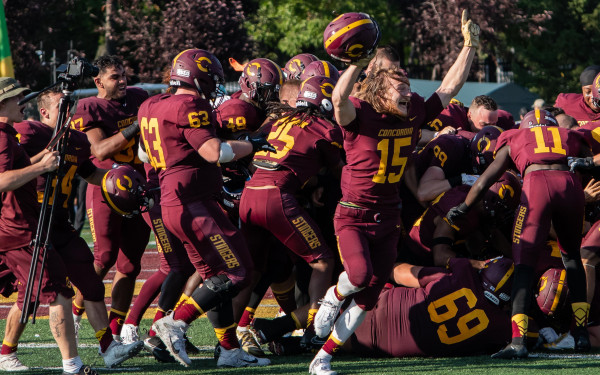Concordia Hosts CFL Eastern Regional Combine
RSEQ’s Best Put on Display In Front of Scouts and Coaches
The best football players from eastern Canada were looking to impress Canadian Football League scouts, and extend their football careers just a bit longer, Friday at the Stinger Dome.
Forty-three of the best football players from the Réseau Du Sport Étudiant Du Québec, as well as the Ontario University Athletics and Atlantic University Sports conferences, were piled into the dimly-lit dome, looking to be one of only five participants to get invited to the CFL’s national combine in Regina.
Supported by friends and family, the players participated to a series of measurements, jumps, circuits and tests to be evaluated as precisely as possible by the scouts of the CFL teams.
“This is a filtered event,” said Ted Karabatsos, Concordia’s offensive line coach. “The CFL knows who they want to see up close in person, and that’s who we saw here today. You never know which one of these guys will catch a scout’s attention.”
“They trained hard for this one day, this is our shot,” said Stingers head coach Mickey Donovan. “This morning I told the guys, ‘Just have fun, but don’t put too much pressure on yourselves, just go out there and do your best to perform at the highest level. ’”
Amongst those in attendance on Friday afternoon were Stingers’ defensive linemen Aldo Sione and J.P Munroe. They had been invited, along with Maximillian Thompson, who was unable to perform due to an injury. While none amongst the trio got a ticket to Regina, they were still pleased with their performances.
“I was nervous when I got in here and saw all the scouts,” said Sione. “But, once I settled down, I think I competed well.”
Meanwhile, Munroe managed to get through the combine while playing through some pain.
“I had a little setback with an injury,” said Munroe. “But I worked through it. They kept me out of the running drills to save my hamstring, but I participated in the field drills and one-on-one’s and the scouts said I did well. My coaches said I did well.”
The combine allows athletes from this region to be exposed to coaches from other parts of Canada. Chris Jones, the head coach and general manager of the Saskatchewan Roughriders, made the cross country trip to Montreal, and was impressed with the level of competition.
“Since I’ve been here, I’ve always liked what I’ve seen out of the Montreal area,” said Jones.
CFL teams are required to have a minimum of 21 Canadian, or “national,” players on their roster. The regional and national combines give coaches the chance to identify players that might be able to contribute to their team, and help satisfy their quota. During this process, CFL coaches will get a chance to strengthen their ties with U Sports coaches.
“It’s always important to have local content,” said Montreal Alouettes general manager Kavis Reed. “Our league is all about strength in the community.”
Carleton wide receiver Malcom Carter, Sherbrooke tailback Anthony Gosselin, Université de Montréal defensive lineman Mathieu Dupuis, Acadia University defensive back Harland Hastings and Sherbrooke linebacker Alexandre Chevrier were the five prospects to punch their tickets to the national combine.
Despite the small pool of prospects lucky enough to get the invitation to the next round, Concordia defensive coordinator Pat Donovan, who ran the event, says the road isn’t done for the players who weren’t selected.
“This event is good to get on someone’s radar,” said Donovan. “Once they see you, even if you don’t go to the national combine, you might get signed somewhere to play special teams.”
“That’s why they all came here and competed.”

_900_600_90.jpg)
_900_600_90.jpg)
_900_675_90.jpg)
_600_832_s.png)

_600_375_s_c1.PNG)
_600_375_90_s_c1.jpg)
1_600_375_90_s_c1.jpg)
